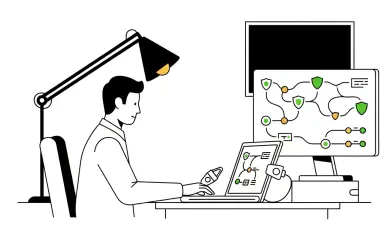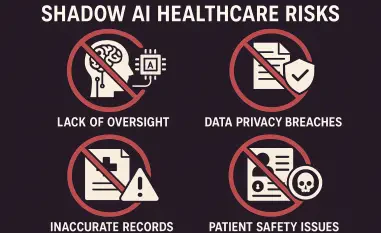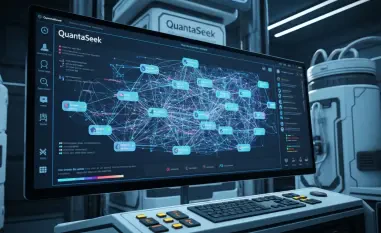Penetration testing, a cornerstone of cybersecurity, is undergoing a significant transformation with the integration of Artificial Intelligence (AI). This evolution is reshaping how vulnerabilities are identified and addressed, enhancing both the efficiency and accuracy of these critical security assessments. As cyber threats become more sophisticated, the role of AI in penetration testing is becoming increasingly vital. This article delves into the various facets of AI-powered penetration testing, exploring its phases, benefits, challenges, and the essential role of ethical hackers in this new landscape.
The Evolution of Penetration Testing
From Manual to Automated Techniques
Traditional penetration testing has long relied on manual methods, where skilled professionals meticulously probe systems for vulnerabilities. However, with the relentless expansion of network infrastructures and the explosive growth in data volumes, manual penetration testing methods have become increasingly time-consuming and unmanageable. The advent of AI has transformed this domain by introducing automated and augmented techniques that significantly enhance the efficiency and accuracy of security assessments.
The shift from manual to automated techniques revolutionizes the penetration testing landscape. AI-powered tools conduct comprehensive analyses of vast data sets at unprecedented speeds, identifying potential vulnerabilities that might elude human testers. This ability to quickly and accurately pinpoint weaknesses ensures that organizations can address security gaps more effectively and efficiently. Furthermore, automated methods reduce the likelihood of human error, offering a more reliable and consistent approach to vulnerability assessments.
Enhancing Efficiency and Accuracy
Incorporating AI into penetration testing has brought about remarkable improvements in the speed and precision of identifying and mitigating security threats. AI algorithms excel at sifting through extensive amounts of data rapidly, detecting patterns and anomalies that human testers might overlook. This enhancement not only accelerates the testing process but also ensures a more comprehensive and accurate assessment of the security landscape.
One of the significant benefits of AI-powered penetration testing is the reduction in human error. Traditional manual methods are prone to oversight and inconsistencies, but AI’s objective analysis minimizes the chances of missing critical vulnerabilities. Additionally, AI can prioritize risks based on their potential impact, enabling security professionals to focus on the most pressing issues. This prioritization ensures that resources are allocated efficiently, addressing the most significant threats first and enhancing the overall security posture of organizations.
Phases of AI-Powered Penetration Testing
Reconnaissance Phase
In the reconnaissance phase, AI algorithms play a pivotal role in automating the data gathering and analysis processes. These algorithms have the capability to scan vast amounts of data from various sources, including social media platforms and dark web channels, to identify potential vulnerabilities with remarkable efficiency. By automating these preliminary tasks, AI allows penetration testers to concentrate on more complex and strategic elements of the testing process, enhancing its overall effectiveness.
The automation of data gathering not only expedites the reconnaissance phase but also improves the accuracy of identifying potential security threats. AI-driven tools can swiftly analyze and correlate data from multiple sources, uncovering insights that would be challenging and time-consuming for human testers to detect manually. This approach ensures that organizations can stay ahead of emerging threats and proactively address vulnerabilities before they can be exploited by malicious actors.
Scanning and Enumeration Phase
During the scanning and enumeration phase, AI tools come into play by automating the processes of identifying exposed services, open ports, and potential vulnerabilities. These tools can perform thorough and detailed scans at a pace far exceeding manual methods, providing penetration testers with a comprehensive map of the target system’s weaknesses. The accuracy and speed of AI-driven scanning tools are unparalleled, enabling security professionals to identify and address vulnerabilities more effectively.
AI-powered scanning tools are proficient at detecting even the most subtle indicators of potential security threats. By leveraging machine learning algorithms, these tools continuously improve their detection capabilities, adapting to new patterns and evolving attack vectors. This adaptability ensures that penetration testers have access to the most up-to-date information, allowing them to stay ahead of cyber threats and safeguard critical systems and data effectively.
Exploitation and Post-Exploitation Phases
In the exploitation phase, AI technology assists human testers by providing valuable insights and recommendations for exploiting identified vulnerabilities. AI’s ability to analyze data and prioritize potential risks based on their impact proves invaluable in this phase. By focusing on the most critical issues, AI enables penetration testers to allocate their efforts more efficiently and effectively, ensuring that the most significant threats are addressed first.
The post-exploitation phase is equally critical, as AI helps monitor compromised systems for any suspicious activities. AI-driven tools aid in the real-time analysis of network traffic patterns and system logs, providing continuous monitoring of compromised environments. This proactive approach is essential for identifying and mitigating ongoing threats, ensuring that any attempts to exploit vulnerabilities post-compromise are swiftly detected and counteracted. By leveraging AI technology in both the exploitation and post-exploitation phases, organizations can enhance their overall security posture and protect sensitive data from potential breaches.
Opportunities and Risks of AI in Penetration Testing
Pros of AI Integration
The integration of AI into penetration testing presents numerous opportunities, significantly enhancing the efficiency and effectiveness of vulnerability assessments. One of the most notable advantages is the speed at which AI can analyze data, leading to faster discovery of vulnerabilities. AI-driven tools can process vast amounts of information within a fraction of the time it would take for human testers, enabling organizations to respond to threats more swiftly and proactively.
Another key benefit of AI integration is the improved risk prioritization offered by machine learning algorithms. These algorithms can assess the potential impact of identified vulnerabilities, enabling penetration testers to focus on the most critical issues first. This prioritization ensures that resources are allocated efficiently, addressing the most significant security threats promptly. AI also automates repetitive tasks, freeing up human testers to concentrate on more complex and strategic aspects of security assessments, further enhancing the overall effectiveness of penetration testing efforts.
Cons and Ethical Concerns
Despite its advantages, AI integration in penetration testing is not without its challenges and ethical concerns. One of the primary issues is the potential for flaws in AI algorithms and the data they use, which can lead to privacy and security problems. AI systems rely on large data sets to function effectively, and if these data sets contain biases or inaccuracies, the resulting assessments may be flawed. This potential for error underscores the importance of human verification to ensure the accuracy and reliability of AI-driven findings.
Another significant concern is AI’s lack of contextual understanding. While AI algorithms excel at identifying patterns and anomalies, they may struggle to accurately interpret complex scenarios and specific vulnerabilities that require a nuanced understanding of the context. This limitation highlights the necessity of human expertise in the penetration testing process. Ethical considerations also play a crucial role, as the use of AI in cybersecurity raises questions about data privacy and consent. Ensuring that AI-powered penetration testing is conducted responsibly and ethically is paramount to maintaining trust and protecting the rights of individuals and organizations.
Real-World Applications and Challenges
AI as a Friend
In the realm of cybersecurity, AI has proven to be a valuable ally, significantly bolstering defenses against sophisticated threats. AI systems like MIT’s AI2 and tools such as Darktrace have demonstrated their ability to uncover unknown vulnerabilities and anomalous behaviors within networks. These advanced AI-driven tools continuously learn and adapt, improving their effectiveness over time and offering insights that might be missed by human testers. Their ability to identify subtle and emerging threats enhances the overall security posture of organizations.
AI-driven tools are particularly adept at handling the complexities of modern cybersecurity challenges. By leveraging machine learning algorithms, these tools can analyze extensive datasets and detect patterns indicative of potential security threats. This proactive approach to vulnerability assessment ensures that organizations can swiftly respond to emerging risks, preventing potential breaches before they occur. The continuous learning and adaptation capabilities of AI systems make them invaluable assets in the ongoing fight against cyber threats, providing organizations with a robust and dynamic defense mechanism.
AI as a Foe
While AI presents numerous benefits in the domain of cybersecurity, it can also be harnessed by malicious actors to launch sophisticated attacks. Techniques such as deepfakes and enhanced phishing have leveraged AI to bypass traditional security mechanisms, posing significant challenges for cybersecurity professionals. The use of AI by attackers underscores the need for continuous vigilance and robust defenses, as these advanced threats can easily evade conventional detection methods.
The dual nature of AI in cybersecurity highlights the importance of staying ahead of emerging threats and continuously enhancing defensive capabilities. Cybersecurity professionals must remain vigilant and adapt to the evolving landscape of AI-driven attacks. By leveraging AI-driven tools and maintaining a proactive approach to threat detection and mitigation, organizations can effectively counteract the sophisticated tactics employed by malicious actors. The ongoing development and refinement of AI-powered security measures are crucial for staying one step ahead of cybercriminals and safeguarding critical systems and data.
Mitigating Challenges in AI-Era Penetration Testing
Addressing Cloud and IoT Security Risks
The integration of AI into penetration testing is particularly crucial for addressing the unique security risks associated with cloud and IoT environments. Cloud infrastructures present a complex landscape with numerous potential vulnerabilities that require constant monitoring and assessment. AI-driven tools excel at identifying weaknesses in cloud environments, analyzing data in real-time, and detecting anomalous behavior that might indicate security threats. This proactive approach ensures that cloud infrastructures remain secure and resilient against potential breaches.
Similarly, the proliferation of IoT devices has introduced new security challenges, as these devices often lack robust security measures and are susceptible to various vulnerabilities. AI-driven penetration testing tools are essential for tackling IoT security risks by identifying weaknesses in communication protocols, firmware, and other components. These tools provide a comprehensive view of potential threats in IoT environments, enabling security professionals to develop and implement effective mitigation strategies. By leveraging AI technology, organizations can enhance the security of both cloud and IoT infrastructures, ensuring that these critical environments remain protected against emerging threats.
Importance of Network Segmentation
Network segmentation remains a vital strategy in the AI era, as it plays a crucial role in limiting lateral movement within networks. Even with advanced AI-driven security systems in place, segmenting networks can prevent attackers from easily accessing critical systems and data. This layered approach to security enhances overall protection by creating multiple barriers that potential intruders must overcome, thereby reducing the likelihood of successful breaches.
Implementing network segmentation involves dividing a network into smaller, isolated segments, each with its own security controls. This approach ensures that even if an attacker gains access to one segment, they are unable to move freely within the network and compromise other segments. AI-driven tools can assist in monitoring network traffic between segments, detecting any suspicious activities, and alerting security professionals to potential threats. By combining network segmentation with AI-driven monitoring and analysis, organizations can create a robust and resilient defense strategy that effectively mitigates the risks posed by sophisticated cyber threats.
Ethics and Certification in AI-Powered Penetration Testing
Ethical Responsibilities
The integration of AI into penetration testing brings with it significant ethical responsibilities. One of the paramount considerations is obtaining explicit consent from the entities being tested. Conducting penetration tests without proper authorization can lead to legal and ethical complications, as unauthorized access to systems and data may violate privacy rights and regulations. Ensuring transparency and securing consent are essential steps in maintaining the integrity of penetration testing practices.
Another critical ethical responsibility is protecting data privacy during penetration testing. AI-driven tools analyze vast amounts of data, and it is imperative to handle this information with the utmost care. Penetration testers must implement robust data protection measures to safeguard sensitive information, ensuring that it is not exposed or misused during the testing process. Responsible reporting of identified vulnerabilities is also crucial. Ethical hackers must disclose vulnerabilities to the appropriate parties promptly and responsibly, allowing organizations to address security gaps and mitigate potential risks effectively.
Professional Certification
Professional certification plays a vital role in equipping penetration testers with the skills and knowledge needed to navigate the AI-enhanced cybersecurity landscape. Certifications such as the EC-Council’s Certified Ethical Hacker (C|EH) program are designed to provide comprehensive training in AI-powered penetration testing techniques. This certification demonstrates a commitment to ethical practices and ensures that penetration testers are proficient in leveraging AI technology to identify and address security vulnerabilities.
Obtaining professional certification not only validates a penetration tester’s expertise but also underscores their dedication to maintaining high ethical standards. Certified professionals are better equipped to handle the complexities of AI-driven penetration testing, ensuring that they can conduct thorough and responsible security assessments. The C|EH certification, for instance, covers a wide range of topics, including AI and machine learning applications in cybersecurity, ethical hacking methodologies, and advanced testing techniques. By investing in professional certification, penetration testers can stay up-to-date with the latest industry developments and enhance their ability to protect organizations from evolving cyber threats.
Conclusion
Penetration testing, a fundamental aspect of cybersecurity, is experiencing a revolutionary shift with the integration of Artificial Intelligence (AI). This innovation is redefining the way vulnerabilities are detected and resolved, greatly improving the efficiency and precision of these crucial security evaluations. As cyber threats grow increasingly complex, AI’s role in penetration testing becomes ever more essential.
AI-powered penetration testing is a multifaceted approach that includes several phases, each benefiting significantly from AI capabilities. From reconnaissance to exploitation, AI enhances the ability to identify hidden weaknesses that might be missed through traditional methods. AI can automate routine tasks, allowing ethical hackers to focus on more intricate aspects of security breaches. Moreover, AI can simulate a vast array of attack patterns, helping organizations prepare for future threats more effectively.
Despite its many advantages, AI in penetration testing also presents challenges. The technology requires continuous updates and can potentially generate false positives, necessitating human oversight to validate findings. Additionally, ethical considerations arise regarding AI’s autonomy in security operations. However, the involvement of skilled ethical hackers remains crucial to interpret AI results and ensure robust cybersecurity measures.
In summary, AI’s integration into penetration testing is transforming cybersecurity, making it more efficient and accurate. This blend of AI and human expertise is vital in protecting against ever-evolving cyber threats.













